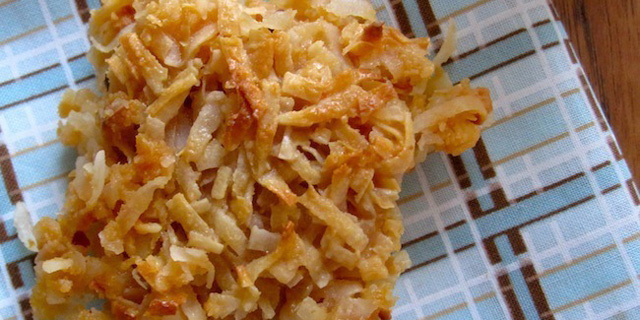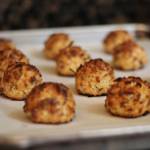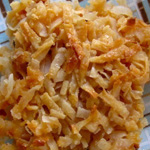Soft, chewy coconut cocadas are a Latin American relative of the classic macaroon cookie. Much like their European counterpart, cocadas consist mainly of shredded coconut, eggs and condensed milk. The origin of the cocada continues to be a subject of debate: some food historians claim Colima, Mexico as the point of origin, while others point out the mention of cocadas in 19th century literature regarding Peruvian culture. Regardless of which country can rightfully lay claim to having invented this sweet, dome-shaped treat, they have nonetheless been a consistently popular comfort food for multiple generations, and continue to sell briskly in Latin American food stores and via street vendors.
As with macaroons, cocadas are traditionally a toasted, golden brown color, though food coloring is sometimes used for extra flair. Occasionally, the food coloring used in cocadas are used to symbolize the flag colors of a particular country, creating a dessert as patriotic as it is delicious. Other variations on the classic cocada involve the addition of whole or chopped almonds; bits of dried fruit; and flavors such as chocolate, cinnamon, coffee, dulce de leche, lime and orange.
The following simple recipe comes courtesy of Food Network chef Ingrid Hoffman, and will yield traditional cocadas, with no food coloring or chopped nuts added. The recipe for Cocadas de Arequipe, or Dulce de Leche and Coconut Bars comes from our friends at the My Colombian Recipes website.
Your choice — we promise, you can't go wrong with either one!
- 3 1/2 cups shredded sweetened coconut
- 3/4 cup sweetened condensed milk
- 2 1/2 tablespoons cornstarch
- 1/2 teaspoon almond extract
- 1 teaspoon vanilla extract
- 1/4 cup confectioners' sugar (optional)
Click here for the full recipe.
Dulce de Leche and Coconut Bars (Cocadas de Arequipe)
- Cooking spray
- 5 cups sweetened shredded coconut
- 1 cup dulce de leche




![Making Mealtime Matter with La Familia: Easy Sofrito [Video]](https://thelatinkitchen.com/wp-content/uploads/2015/10/sofrito-shutterstock__0-500x383.jpg)
![Easy Latin Smoothies: Goji Berry Smoothie [Video]](https://thelatinkitchen.com/wp-content/uploads/2015/12/goji_berry-shutterstock_-500x383.jpg)
















![Fun and Fast Recipes: Fiesta Cabbage Salad [Video]](https://thelatinkitchen.com/wp-content/uploads/2015/11/fiesta_cabbage_slaw-shutterstock_-500x383.jpg)









